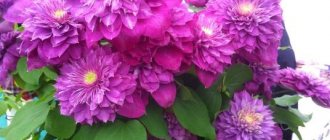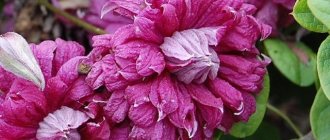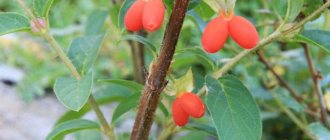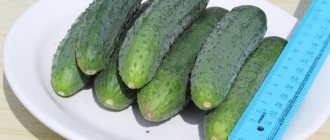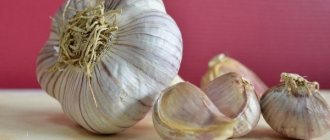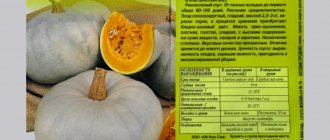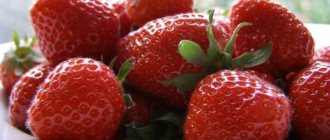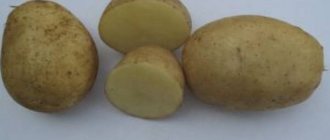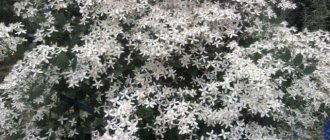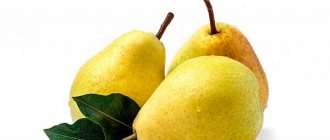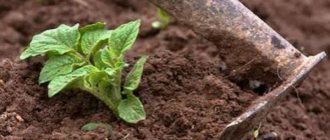History of selection
Clematis (clematis) Manchurian is a wild plant from the buttercup family. Found naturally in Russia, China, and Japan. In Russia, clematis appeared at the end of the 19th century. They were used as greenhouse crops. In the USSR, the cultivation of Lozinka, another name for Manchurian clematis, began in 1950. For the first time, thanks to breeder M.A. New varieties were obtained through hybridization. As a result of her work, more than 50 species of clematis and Manchurian hybrids were bred.
Description and features
This Far Eastern Clematis is a perennial plant that belongs to the ranunculaceae family. It first began to be cultivated in the Russian Far East, Korea and Eastern China.
Its stems are green and flexible, they do not become woody. The leaves have a complex structure - they consist of 3-7 smaller parts.
If shoots are formed in the current year, flowering occurs in June and July.
Clematis Manchurian is considered one of the most unpretentious varieties.
The flowers consist of four white oblong petals. In most cases, the length of the vine is 1.5 meters. Sometimes it can reach up to 3 meters. The plant has a pleasant fragrant smell. It intensifies in those Clematis that grow in a well-lit place. Breeder Beskaravainaya M.A. received more than 50 hybrid varieties based on this species.
Origin
Clematis Manchurian is a wild Far Eastern plant. It began to be grown in Russia at the end of the 19th century. In the USSR, its breeding began in 1950.
Description of Manchurian clematis
This culture has long branched stems, as it is a vine. It grows up to 3 meters, curls upward, entwining all the relief surfaces in its path. Due to this, clematis is used for landscaping garden plots, park areas, and any vertical surfaces.
Clematis leaves are compound, consisting of 3–7 small leaves of dark green color. The inflorescences of the Manchurian flower appear only on young shoots of the new year. To increase the number of buds, clematis is pruned for the winter. The flowers of clematis are white, small, and densely growing. The inflorescence consists of 4 oblong petals. From 150 to 500 buds grow on one shoot. As they warm up in the sun's rays, they begin to emit a strong aroma. It can be heard even if you are a few meters from the bush.
Important!
If there are allergy sufferers in the family, it is not recommended to plant clematis near a living space. The strong aroma of the Manchurian flower can trigger an attack.
Flowering dates for Manchurian clematis
When the plant blooms, hundreds of decorative snow-white flowers can form on it. The fruit is a multi-nut. Clematis blooms from the last days of June or from the first days of July.
The stems branch, entwining buildings, stones, and ledges that are located side by side. The variety is famous for its rather specific but pleasant aroma, especially noticeable when the sun hits the flowers. The plant also has a burning juice that causes irritation when the mucous surfaces come into contact with the surface of the flower.
Trimming group
There are 3 categories of circumcision. The variety we are considering belongs to category 3. This group consists of clematis that bloom for a long time; flowers appear on the shoots of this season.
Clematis in this category are famous for their unpretentiousness, therefore, preparing them for the winter season is not so difficult. After pruning, as a rule, fairly shortened shoots remain on the bush.
Where does clematis of this variety grow?
Far Eastern Manchurian vine-leaved clematis is quite undemanding and has good tolerance to lack of water and frost. The plant is located along rivers, lakes, on hills and meadows. The bushes like to grow in the sun, in areas where it is moderately humid.
Source
Clematis Manchurian. Instructions for use. Сlematis manschurica.
Abridged article.
Clematis, translated from English, is a temple of the holy root, widely used in traditional medicine of the East, mainly in complex treatment with other herbs, both for internal and external use. It is believed that Manchurian clematis treats more than 20 types of diseases, but in fact the list for the use of clematis is larger, due to its rich chemical composition of potent substances and, therefore, a large number of pharmacological effects. Orthopedics, pediatrics, obstetrics, gynecology, oncology - this is an incomplete list of disciplines where Manchurian clematis has been successfully used for centuries. Like any strong drug, clematis has many side effects, you need to remember this.
Clematis has a pronounced anti-stress effect, i.e. reducing the effect of another stronger substance
In Eastern medicine, Clematis Manchurian is widely used to treat pain and is believed to promote the circulation of Qi in the main energy channels and Luo vessels, as well as expel wind and dampness. Ideal patients for treatment with clematis are, to a greater extent, people who are freezing, with a feeling of numbness, limited movement, pain (especially in the lower extremities) and even paralysis. Clematis Manchurian is used more for the treatment of superficial pain (muscle and bone), and for the treatment of large bones and deeper penetration, an additional combination with other herbs is used. Long-term use of clematis inhibits conditioned reflexes, motor activity, breathing, digestive function, and reduces the weight of the spleen and thymus, i.e. reduces the patient’s immune status, which requires additional strengthening of Qi. Thus, there is a need to use various adaptogens, stimulants of Qi energy, for example, codonopsis, ginseng, astragalus, atractylodes, honey, sea buckthorn fruits, licorice, etc.
In the East, they believe that Manchurian clematis has a pungent and salty taste, slightly bitter, warm, and has an affinity for the bladder and liver canal.
The aboveground and underground parts of the plant have significant differences in composition, but the roots, like clematis herb, are used in folk medicine.
Clematis Manchurian is used:
-As a strong anti-inflammatory, antimicrobial, antifungicidal and antioxidant, thrombolytic agent . It is more effective to use an alcohol extract, which to a large extent blocks the production of pro-inflammatory mediators, nitric oxide and prostaglandin E. FRESH flowers and leaves of the plant, which are preserved with aqueous-alcohol solutions in 60-70% alcohol, have good antimicrobial activity. Dried raw materials do not have antifungicidal activity, tinctures from fresh raw materials contain a lot of protoanemonin (an oily yellowish liquid with a sharp specific odor that irritates the mucous membranes), has strong antifungal activity and is poisonous. Clematis preparations are effective against Staphylococcus aureus, streptococci, Escherichia (Escherichia coli), Candida albicans (yeast-like candida) and Shigella shigae (Shigella dysentery), Neisseria gonorrhoeae (gonococcus gonorrhea). The antimicrobial properties of the plant are attributed to the action of protoanemonin and its derivatives, which have a strong effect on gram-positive and gram-negative bacteria and fungi, Penicillium glaucum (blue mold fungus, for some cheeses), Aspergillus niger (Black mold), Mucor griseocyaneus. According to scientific studies, the concentration effective for suppressing diphtheria is 1: 12500, and for Mycobacterium tuberculosis and E. coli 1: 50000. Clematis preparations are used to treat filariasis - helminthic infestations of small roundworms and nematodes.
Oriental medicine recipe.
For the treatment of filariasis, a decoction of 1 kg is made. fresh crushed roots, boil for 30 minutes, with the addition of 1 kg. brown sugar and 2 liters of white wine. The dosage is of great importance. The medicine taken in one course is more effective than the same amount in two courses. There are few side effects; there is a burning sensation in the stomach, nausea, and a slight increase in temperature. The course of treatment is at least 5 days, at least 1 kg. roots per day.
— For the treatment of various diseases of the musculoskeletal system, in the form of analgesic, anti-inflammatory, anti-edematous and chondroprotective effects.
For the treatment of rheumatic diseases in the shoulders and arms, arthritis or arthralgia associated with cold, ankylosing spondylitis, chronic, nagging pain in the lower back, lumbosacral radiculitis, degenerative diseases of the joints, with decreased mobility in them, swelling of the legs, discomfort when walking, pain when flexion and extension of joints, muscle cramps, injuries, bruises, fractures, prevention of osteoporosis, treatment of gout. For pain in the legs and lower back, root powder is effective when mixed with warm white wine or as a root roasted in wine. This combination better disperses cold, cleanses collaterals and blood vessels, reduces thrombosis and mucus stagnation.
Eastern Medicine Recipes for Arthritis:
Take 1 kg of crushed clematis roots, and 1200 ml white wine, a pot of meat, simmer for an hour and a half, strain. Take 15 ml., 3-4 times a day.
— For the treatment of cancer . The antitumor effect of clematis is exerted by phenolic glycosides, polysaccharides, essential oils, flavonol (quercetin), carophylline (oleanoic acid), and triterpene saponins. It has an antitumor effect on many types of cancer. Clematis Manchurian can be combined with the use of chemotherapy , while increasing their effectiveness by stimulating blood circulation, reducing pain, and having a direct antitumor effect.
Clematis reduces spasm of the throat and esophagus, increasing their peristalsis, and can also help stimulate intestinal motor function.
— For the treatment of liver and gallbladder diseases, acute hepatitis with jaundice, fatty hepatosis (fatty liver).
Clematis preparations increase bile secretion, relax the muscles of the bile ducts, and reduce inflammation. Due to the combination of choleretic, anti-inflammatory and antispasmodic effects, treatment of acute infectious hepatitis with jaundice is achieved.
Oriental medicine recipes:
- Take 9 g. Manchurian clematis root, crushed into powder, 1 chicken egg, mix everything with vegetable oil, make scrambled eggs. Use 3 times a day, 3 days in a row. Avoid beef, pork and sour foods.
- Take 15 grams. crushed clematis manchurian roots and licorice roots, make a decoction, take throughout the day. For the treatment of small stones and bilirubin stones, larger dosages of 2-4 times are used. The recipe promotes the secretion of bile and allows you to relax the sphincter of Oddi (exit sphincter of the common bile duct) and the sphincter of the gallbladder.
Article on the topic: Common bedrenets - useful properties, description
The importance of clematis in the expulsion of Wind-Moisture syndrome emphasizes its importance for increasing the function of the liver and bladder channels, increasing circulation in them.
- As an antihypertensive agent. Clematis preparations increase circulation, reduce congestion and cholesterol levels in the blood serum. At the same time, clematis infusions reduce blood pressure levels more strongly than decoctions, on average by 3-5 times.
— Helps normalize urination , i.e. increase the diuretic effect in case of swelling or reduce it in case of fluid deficiency in the body. Similar results are typical for preparations of both aboveground and underground parts of clematis.
— For the treatment of psoriasis , chronic eczema with severe itching , scabies, in the form of a decoction or oil.
— For the treatment of hormonal diseases of women , breast enlargement, reduction of wrinkles, sagging skin, stimulation of labor, increased menstruation, treatment of inflammation of the mammary gland, amenorrhea.
-For the treatment of brain diseases, as an antispasmodic, sedative, anti-inflammatory, decongestant, for the treatment of Parkinson's disease, neuralgia, epilepsy, facial paralysis, hemorrhagic stroke, headaches, general pain associated with cold symptoms, anemia of body parts. Treating Parkinson's disease by reducing the number of dopaminergic neurons destroyed.
— To remove fish bones stuck in the throat.
Oriental medicine recipes.
A thick decoction of clematis root (30 g) is made with the addition of angelica dahurian root (3 g), tea tree (5 g), licorice (4 g) and drunk slowly over 30-60 minutes once or twice a day. at this dosage.
— For the treatment of hemorrhoids.
Usually they combine a decoction of the roots of Manchurian clematis and Saposhniovia divaricate, which grows abundantly in the eastern part of Russia, 60 grams each. for external use.
— For the treatment of diabetes mellitus , as a means of slightly reducing blood glucose levels.
— For the treatment of tonsillitis, pharyngitis, acute epiglottitis.
Recipes of Eastern medicine.
Take fresh clematis leaves and flowers. Squeeze out the juice of the plant, and place a tampon soaked in the juice in your nose, wetting the tonsils of the mouth and mucous membranes. Use for about 5 minutes, which immediately relieves the condition. Apply at intervals of 4-6 hours.
Preparation of drugs and dosage.
— Infusion of Manchurian clematis herb . 20-30 gr. dry herbs, pour a glass of boiling water, leave in a thermos for 30-40 minutes, strain. Take 1/3 cup 3 times a day.
— Tincture of Manchurian clematis herb . 20-30 gr. dry herbs, pour 60% alcohol, leave for 2 weeks in a dark place, shaking occasionally. Strain. Take 20-30 drops 3 times a day, 30 minutes before meals.
Decoction of Manchurian clematis roots . Chopped dry root 5-10 g, pour 330 ml. water, bring to a boil, but do not boil for 15 minutes, take 1/3 cup 3 times a day before meals and for external use for cancer. If a bone gets stuck in the throat, increase the dosage to 30 g.
Tincture of Manchurian clematis roots . Fill a glass jar 1/3 full with crushed dry roots, fill to the top with 60% alcohol, leave for 2 weeks. Strain. Take 10-20 drops 3 times a day in oncology.
Use of Manchurian clematis capsules 3-4 capsules twice a day; for severe pain, increase the dosage to 6 capsules every 6 hours.
Aqueous-alcoholic extracts remain effective for about 7 months; heat drying is excluded.
Contraindications and warnings.
- When ingesting large dosages or with prolonged use, the following are possible: bleeding from the gastrointestinal tract, burning, swelling, oral ulcers, diarrhea, bradycardia, shortness of breath, cold sweat. A rash with blisters may appear.
— Do not use the herb if your immunity is low.
- Do not use for a long time in patients with kidney disease due to toxicity.
The article lacks a chapter on ways to enhance the effect on the human musculoskeletal system, enhance the anticonvulsant and analgesic effects, weaken the harmful effects on the skin, the chapter on antitumor treatment with clematis is shortened, and the chapter on the preparation of preparations from clematis is shortened. The full article will be published in a forthcoming book.
Tsvetkov Sergey Ivanovich, oncologist, herbalist, Novosibirsk.
Characteristic
Clematis is a liana-like, flowering, perennial plant that reaches a height of 150-300 cm. The leaves are arranged oppositely, most often they are entire, odd-pinnate or trifoliate, less often - twice trifoliate.
The perianth consists of 4-8 sepals. The flowers of this species are white and consist of 3-7 petals. During the flowering period, up to several hundred beautiful, snow-white flowers can form on one plant. The fruit of Clematis Manchurian is a multi-nut. The flowering period occurs at the end of June - beginning of July.
The stems are branched, entwining nearby structures, stones and ledges. Clematis Manchurian has a rather specific but pleasant aroma, which is especially noticeable when the flowers are exposed to sunlight, as well as a burning juice, which causes irritation when it comes into contact with mucous surfaces.
Frost resistance, drought resistance
Clematis Manchurian grows in well-lit, open places with abundant watering. Tolerates winter frosts well. If you prepare it and wrap it up for the winter, it will not die even at -40 °C.
Clematis needs moderate moisture. Shrubs should not be planted near groundwater. But it also does not tolerate drought well. Clematis dies under the influence of strong winds and drafts. Manchurian clematis should not be planted on the northern side of the site. It grows better in sun than in partial shade. Tolerates temperature fluctuations well. Growing Manchurian clematis will not cause much trouble for the owner.
Resistance to diseases and pests
Dangerous pests for Manchurian clematis are slugs, snails and spider mites. They fight it with the help of acaricides - chemical preparations for destroying pests of agricultural crops. Slugs and snails are collected by hand.
The main diseases to which clematis Manchurian is susceptible
- fungal infections;
- gray rot;
- powdery mildew;
- rust.
It is necessary to treat the bush with a solution of foundationazole or Bordeaux mixture. A particularly dangerous pest for clematis is the root-knot nematode. The worms infect the rhizome and the plant dies. The only way to deal with them is by uprooting and burning them. When purchasing clematis, you must carefully inspect the roots.
Brief description of the plant
The homeland of Manchurian clematis is the Far East, namely one of the historical regions of China, which gave the name to the flower. The word "clematis" translated means "vine shoot" or "climbing plant." Lianas of the Manchurian species do not at all resemble grapes, but they reach more than one and a half meters in length , forming a huge beautiful bush strewn with small white flowers. The plant is a herbaceous perennial; sometimes it is also classified as one of the forms of clematis straight.
Clematis Manchurian in flowering period
This species has a pleasant, but very pungent odor, which is especially strong in the sun, so allergy sufferers should be careful.
The stems of this variety are very branched and climb up any structure, be it a special arch or a wall. The liana has leaves of a complex structure, which combines from 3 to 7 leaves . The flowers are small, white, consist of four oblong petals and form inflorescences. One vine can be crowned with up to 500 flowers at the same time.
This species is unpretentious and grows well in our climate, withstands frost and temperature fluctuations, and does not require special care. The most abundant flowering is usually in June-July.
Beneficial properties of Manchurian clematis
Eastern medicine has long recognized the healing properties of the plant. Decoctions and tinctures are made from it.
It is used in the following cases:
- for rheumatic, neuralgic pain, as well as arthritis, bruises, gout, use a decoction of clematis roots;
- for inflammatory diseases of the respiratory tract, viral diseases - drink a herbal decoction from the plant regularly;
- for diseases of the eyes and oral cavity, lotions are good;
- use for baths to eliminate skin inflammation, irritation, even with varicose veins;
- clematis tincture is actively used in the East for the treatment of heart and vascular diseases;
- in combination with other drugs for the treatment of oncology.
It’s easy to make a decoction or tincture using clematis at home. The roots of this plant are also used in folk oriental medicine.
Important!
Before use, consult a doctor, as this product has contraindications. It is believed that to date, the plant has not yet been sufficiently studied.
Tincture recipe:
Take 50 grams of dried herb and pour 2 cups of boiling water, then place this liquid in a thermos and leave for half an hour. Drink 1/3 tbsp. three times a day.
All that Clematis Manchurian requires in caring for itself is pruning, watering, and fertilizing. This is incommensurate with its lush and fragrant flowering and decorative properties.
Source
Clematis Manchurian: use for medicinal purposes
Manchurian clematis: Clematis manschurica Rupr. Ranunculaceae Juss family.
Clematis Manchurian is a perennial plant with recumbent or ascending stems that cling to the branches of surrounding shrubs with curved leaf petioles.
Stems are branched, ribbed, herbaceous. The leaves are pinnately dissected with spaced primary lobes, entire or trifoliately dissected, the lobules are sessile or petiolate, slightly leathery, lanceolate-ovate with a wedge-shaped or heart-shaped base. The upper leaves are often trifoliate. The flowers are small, numerous, collected in terminal and axillary inflorescences. Sepals are white, oblong, up to 1.5 cm long, more or less narrowed towards the base, densely white pubescent on the lower sides along the edges, anthers linear, glabrous, with a thickened edge; columns up to 3 cm long. Blooms in July-August. Distributed in the Far East (Amur region, Primorye). General distribution; China, Korea.
Grows on dry slopes, forest edges, bush thickets, sparse deciduous forests, sandy river banks. The roots and aerial parts harvested during flowering are used for medicinal purposes. Clematosides A, A1, B1 and C were found in the roots of the plant. Vitamins C, P, as well as traces of quercetin were found in the leaves. The flowers contain vitamin C, kaempferol, and quercetin. The plant has analgesic, diuretic, hypotensive, hypoglycemic and anti-stress effects.
A decoction of roots and rhizomes is used in Chinese and Korean folk medicine as an analgesic for neuralgia, rheumatism, pain from bruises and contusions, and paralysis of the facial nerve. In addition, in China they drink a decoction for colds, sore throat, viral hepatitis, and externally in the form of lotions from the decoction is used for toothache and ulcerations of the cornea. The population in Primorye uses an infusion or decoction of the herb as a painkiller for arthritis, rheumatism, and gout. The population steamed with fresh grass for rheumatism.
The Nanais use baths from an infusion of the herb to treat thrombosis of the extremities resulting from blockage of the venous vessels. Juice and crushed fresh grass cause the formation of blisters on the skin (A.I. Shreter, 1975).
Methods of preparation and use:
1. 5 g of crushed roots per 300 ml of water, boil over low heat for 7-8 minutes, leave for 1 hour, strain. Take 1/3 cup 3 times a day for rheumatism, arthritis, neuralgia, facial paralysis.
2. 8 g of dry crushed herb per 1 glass of boiling water, leave for 2 hours, strain. Take 1-2 tablespoons 3 times a day.
3. 600 g of herb per 3 liters of boiling water, leave for 2 hours, strain. Use for a full bath in the treatment of venous thrombosis of the lower extremities.
Choi Taesop (1975) offers the following recipes:
1. Chinthonkhwan tablets. 125 g each of angelica, Chinese aralia cordata, clematis, angelica daurica, an appropriate amount of honey and aseptic agent; total volume 1000 g. Gently grind the medicinal mixture into powder, prepare honey tablets, take 5-6 g 3 times a day as a painkiller for rheumatic diseases and various neuralgia.
2. "Rencheoncheton." 4 g each of clematis, peony roots, pueraria roots, azure roots, leaves and stems of catnip, angelica chinensis, aralia cordata, angelica dahuriana, atractylis, skullcap angustifolia, fruits of unripe poncirus, Korean bellflower and zhgun, 2 g each of angelica multiforme root, black cohosh stinky, licorice. Prepare a decoction from medicinal plants and drink daily, using two equal doses of dry matter for the decoction. Use as a pain reliever for inflammation, aches and pain in the joints.
3. Clematis decoction. Clematis 15 g, atractylis rhizome 10 g, 8 g each of azure root, angelica dahurian, large burdock seeds, 5 g licorice. Prepare a decoction in water and take 2 times for urticaria.
4. Common recipe. Prepare an aqueous decoction from 80 g of clematis and thicken it, pour 20 g of Aralia cordata bark with 200 ml of 50% alcohol, leave for 48 hours, strain; Combine both mixtures and take 20 ml 3 times a day. Used for rheumatoid arthritis.
Ancient Korean recipes:
1. For rheumatism and neuralgia, for pain in the lower back and legs, it is recommended to infuse 0.6 kg of clematis in vodka for 7 days, then crush it into powder, mix with flour paste and prepare small tablets. Take 20 pcs. along with the vodka that clematis insisted on.
2. For paralysis of the limbs and severe pain from bruises and injuries, it is recommended to grind 18.75 g of clematis and 150 g of curly borer roots into powder, mix with a paste diluted with table vinegar, and prepare small tablets. Take 7 pieces along with salted broth.
3. For colds, it is recommended to grind clematis into powder, mix with honey, prepare small tablets and take 10-20 pieces. along with ginger decoction (Choi Taesop, 1987).
Other recipes:
An infusion of this taiga medicinal plant (external remedy) treats bone diseases, such as arthritis, arthrosis, sancroiliitis, spondylosis, sciatica, radiculitis, salt deposits, myositis, osteochondrosis, bone growths on the feet and bones, thrombophlebitis of the internal veins, pneumonia, complications after acute respiratory infections and flu. Having an anti-inflammatory pulling effect, it will help with the bites of bees, wasps, bumblebees and even snakes.
Contraindications: skin diseases.
To quickly relieve pain, you will need to moisten the sore spot with this infusion 2-3 times every 5 minutes.
For healing, overnight compresses of 1 tbsp are needed. l. infusion and 1 glass of hot urine. The remaining liquid is suitable for the next use. Breaks are allowed up to 3 days. A total of 15 procedures. In the first week, a sensitive exacerbation is possible.
In case of pneumonia, complications after the flu, bronchitis, acute respiratory infections, sore throat, you should prepare in advance two layers of gauze for a compress, cotton socks, mittens or clothing - depending on the diseased organ, as well as soft cellophane. Wrap something warm on top.
In case of skin irritation, after rinsing, lubricate the area with sterile vegetable oil (if you continue compresses, you can replace urine with vodka). Eliminate spicy and salty foods from food.
The approximate time for applying the compress depends on the age of the patient. So, for children from 1 to 2 years old - 40 minutes; from 2 to 4 years - 50 minutes; from 4 to 6 years – 2 hours; from 6 to 12 years and more - from 3 to 8 hours. Focus on the patient's condition. If the disease is neglected, repeat the treatment. If there is reason to think about a complication on the head, legs, arms, or sacrum, you need to make a continuous compress (wrap the patient up from head to toe for the specified time).
Article on the topic: Black Voronets - useful properties, description
Such a compress can remove all inflammation and negative consequences of antibiotic treatment in one day. It does not heat, so it can also be used for cancer.
About Manchurian clematis, the reference book “Far Eastern Medicinal Plants” says: “It is known that the venom of Far Eastern snakes spreads through the blood throughout the body within 10 minutes, and any help in the taiga may be late. However, it is known that the local inhabitants of the taiga - Nanais, Evenks - do not go without a tincture of this plant. A cloth soaked in it and applied to the bite site neutralizes the poison.”
Laboratory studies of clematis did not yield any results. Apparently, scientists will still have to take a closer look at this plant.
“Old Ulukitkan, when his shoulder was bitten by hornets, rubbed his shoulder with clematis, and the terrible pain began to subside after 10 minutes,” wrote the famous traveler Arsenyev.
I also once had to save a 5-year-old girl. It was about 20 years ago in the village. The girl sat with her bare bottom on the swing where the bumblebees were sitting. Several bumblebees left their stings. The girl screamed so that her eyes seemed to pop out of her sockets. Fortunately, I always have clematis tincture with me. I applied a cloth soaked in tincture to the bite site, and after 10 minutes the girl calmed down.
Reproduction
When propagating a plant, several methods are used. Using layering requires less effort and is safer than root division.
Seeds
This type of Clematis grows well on the shoots of the current year. It is recommended to use the seeds that can be obtained from them for planting. In this case, the germination rate will be higher than from last year's shoots.
In order to improve germination, the seeds are left in water for 5-7 days. They are then placed in plastic containers or wooden boxes. A soil mixture is used: fertile soil, peat and sand in equal parts.
When planting, the seeds are planted shallowly and sprinkled with a small amount of sand on top. In order for them to germinate, the best temperature is 25-28 degrees. They are covered with glass or film on top. It is important to regularly moisten the soil. It is recommended to water the sprouts not from above, but using a tray. A little water is poured into it and it is sucked into the soil through holes in the bottom of the container.
When leaves appear on the sprouts, you can plant clematis in a permanent place. Seedlings are placed at a distance of at least 20 centimeters between them. They are grown for several years and after flowering, 2-3 years later they are transplanted to a permanent place.
By layering
Grooves are made next to the bush, into which the branches are bent. These shoots must be strong and healthy. They need to be covered with earth so that only the tip of the branch remains outside. Rooting will occur within a year. After this, you need to disconnect the layering and plant it separately.
Cuttings
In the spring, after the snow melts, the plant wakes up and begins to grow. Manchurian clematis is pruned completely for the winter, so its first young shoots appear closer to May. At the same time, cut 1-2 vines into cuttings. Each of them should contain 2-3 live buds. It is convenient to root them both in water and in soil, but the latter option is preferable.
It is better to take the following composition of the substrate: fertile soil, vermiculite, perlite. The cuttings are first dipped in Kornevin for 2-3 hours, then placed in the ground, watered with water and covered with a jar on top. In such a greenhouse, at +25°C, rooting occurs in 2-3 weeks. As soon as a new leaf appears on the cutting, it has taken root and is ready to remove the greenhouse.
The cuttings are gradually accustomed to room temperature. During this period they are still vulnerable. It is important that there are no sudden changes in temperature. This period usually coincides with the end of the heating season in apartments, but a sudden cold snap in the room can destroy a young plant. The cuttings are placed next to a heater or lamp, gradually accustoming them to a lower temperature. They are planted in the ground in the summer - in July.
Dividing the bush
To use this method of propagation, plants that are 5-6 years old are suitable. Their roots are dug out of the ground and divided into two parts. It is necessary that each of them has intact roots and buds. After separation, both roots are planted in a permanent place.
Source
Reproduction of clematis Manchurian
To propagate clematis Manchurian, you can use the following methods:
- cuttings;
- bush division;
- using layering;
- propagation by seeds.
Attention! Planting this variety is not a quick process. It takes two to three years after sowing for complete establishment.
Cuttings
A simple method of rooting: you need to trim new, young shoots with buds at the very peak of flowering and root.
Dividing the bush
Applies only to plants over 5 years old. In the autumn, you should dig up the bush along with the roots and divide it into parts. Plant and root two or three seedlings obtained as a result of division.
By layering
This propagation method is suitable for adult 6-year-old plants. They have long shoots that are great for rooting. It is necessary to select the shoot with the largest number of buds - it is tilted towards the ground, sprinkled with soil. When propagating clematis by layering, systematic watering is required. After the roots appear, the young bush is transferred to another place and rooted.
Growing Manchurian clematis from seeds
Clematis reproduces by shoots and seeds. The last method is quite labor-intensive and time-consuming. You can get Clematis Manchurian from seeds at home 2 years after sowing.
Deadlines
The seed will develop into strong shoots, which are planted in open ground in the spring. All this time they are in wooden and plastic containers for seedlings. The optimal time for sowing is February-March. After 1.5 months the first shoots will appear.
Preparing the container and soil
Wooden or plastic seedling boxes are suitable for planting. They are filled with a mixture of garden soil with sand and peat in equal parts. Such soil promotes air circulation and moisture does not stagnate.
Important!
Before planting, seeds are soaked in a small amount of warm water for several days. This way they will rise faster.
Sowing Manchurian clematis seeds
For planting, take the seeds of the current year. They will give the greatest germination. Select seed that is dry and without damage to the protective layer. The seed is not spread densely on the surface of the moistened soil; it is not recommended to deepen it. Sprinkle sand on top. A few hours before sowing, the filled boxes are placed in the refrigerator. This will harden the seedlings.
Reproduction methods
Manchurian clematis, like many other species: Tangut, brown, burning, isabel, semu and others, can be propagated in four ways:
They are sown in early March, and shoots should appear within a month and a half. The seed is soaked for 5-7 days and then sown in a container, which is covered with film to maintain the optimal temperature. Once the air temperature stabilizes, the seedlings are transplanted into the garden bed.
About a third of the vine, on which buds have already appeared, is cut off, then it is divided into cuttings of two nodes on each. The cut from above should be straight, about 3 cm from the node, and from below - an oblique cut with a distance to the node of 7-10 cm. This operation is also performed in the spring.
A groove is dug near the bush, where an adult shoot is placed and covered with earth, leaving only the top. After a year, the rooted shoot is separated.
Dividing the bush
Only “adult” bushes that have been growing in one place for at least 6 years are suitable for this operation. Such propagation will be most painless for the plant in the fall. Clematis is dug up by the roots, carefully divided into two parts and planted separately.
Planting Manchurian clematis
Clematis is planted in the autumn-spring period. In order for it to take root and grow quickly, it is necessary to take into account the characteristics of the soil, choose the right Manchurian seedling and planting site.
Recommended timing
Any warm season of the year is suitable for planting clematis seedlings in open ground: spring, summer, autumn. The main thing is that the air temperature is above +5 °C. A Manchurian flower with an open root fades quickly - planting is carried out immediately after its acquisition.
Choosing a suitable location
Clematis Manchurian grows well on the sunny side of the site. The bush is planted a meter from the support. The root system needs room to grow. The flower should not be planted under drains - clematis does not tolerate excess moisture. It is also important to make sure that the groundwater is deep enough to prevent the root from rotting.
Important!
The windy side of the garden is not suitable for clematis - it withers from drafts.
Selection and preparation of planting material
You can purchase healthy seedlings in specialized nurseries. It should be carefully inspected before purchasing. The shoots and root system should not have creases, damage, or pest larvae. The leaves are clean, without white or red spots or ulcerations.
Landing algorithm
Several months before planting, the soil is prepared: it is dug, loosened, and fertilized. For the seedling, dig a hole 60 cm deep and wide. Fill it one-third with a mixture of soil with sand, peat, humus, and wood ash in equal parts. If several clematis are planted, the distance between the holes is at least 1 m. The support is installed before planting so as not to damage the roots.
Agricultural technology for planting clematis Manchurian:
- The rhizome of the seedling is soaked for several hours in a solution of water and a growth stimulant.
- The pit is filled with crushed stone, expanded clay, and small stones - this is drainage.
- This layer is covered with the prepared fertile mixture so that 20 cm remains to the top and watered.
- The seedling is placed vertically in the hole, the roots are straightened, and covered with the remaining soil. It is necessary to ensure that the root collar is closed by 15–20 cm. This is the only way clematis will develop a strong root system.
- Afterwards, the soil is mulched, covered with peat and sawdust. A clematis seedling is attached to a support and watered abundantly.
Manchurian clematis will begin to grow rapidly after 3 years. Flowering can be observed in the 5th–6th year.
Landing
Shrubs are always planted in the ground in autumn or spring. For successful plant growth, it is important to take into account the composition of the soil and the planting location.
Choosing a place and time of landing
When planting, it is best to give preference to an open area. Clematis is often planted next to fences, buildings and gazebos so that the clematis can later weave.
Important! You should not plant clematis on the north side of any building.
It is also worth making sure that the selected area does not have groundwater located close to the surface of the earth. Clematis Manchurian does not tolerate strong humidity and wind.
Selection of seedlings
When choosing a seedling, you should pay attention to the condition of the shoots and root system. There should be no severe damage, creases or cracks. Also, Clematis Manchurian should not have obvious signs of disease or pest damage.
It is best to contact trusted nurseries that specialize in growing and selling ornamental outdoor plants.
Soil requirements
Clematis Manchurian needs nutritious and fertile soil. You can use a ready-made substrate for flowering and perennial plants, or you can add mineral fertilizers, humus, ash, peat and other organic components to the soil when planting.
How to plant
The main stages of planting shrubs:
- First you need to dig a hole in the selected area, the diameter and depth of which is about 60 cm.
- The excavated soil should be mixed with organic and mineral fertilizers, and crushed stone or expanded clay should be poured into a thin layer at the bottom of the hole.
- Next, you should gradually fill in the mixture of soil and fertilizers and form a small elevation. Then you need to pour water until it shrinks completely.
- The seedling is located in the center of the hole, the root system is carefully straightened out.
- Gradually, the roots of the seedling need to be covered with earth until the root collar is deepened by 12-15 cm.
- At the last stage, it is important to mulch the soil around the seedling with peat or sawdust. Clematis is tied to a support, and the ground around is abundantly watered.
Advice! It is best to install the support before planting clematis to avoid damage to the root system.
Caring for Manchurian clematis
To ensure that the plant does not die, takes root well and blooms, it is necessary to provide it with proper care. It is important to follow the rules of watering, do annual pruning, and insulate clematis in winter.
Source
Watering
With good drainage and light soil, water the flower frequently, especially on hot days. The volume of liquid depends on the age of the plant. For a young seedling, 2 liters may be enough, while 20 liters will not be enough for an adult bush. Watering frequency - 2 times a week.
Watering is especially necessary in hot summers. At temperatures above +27 °C, water clematis daily, more precisely, every evening. During daylight hours, the procedure is contraindicated; this can greatly harm the plant. Sometimes in the evenings the bush is sprayed with rainwater. It is also permissible to fertilize the flower using the foliar method - leaf by leaf.
Important!
Water should not be poured under the trunk itself, but into the circle around the trunk, 10-15 cm from the center of the bush. This way, the branched roots of clematis are better saturated with moisture.
Top dressing
If during planting the soil was mixed thickly with humus, compost and fertilizers, then the plant will not need feeding for the first year. Overfeeding will be dangerous for the young seedling. It should be fertilized from the second year, immediately after the snow melts. In spring, the liana needs nitrogen to grow and intensively increase green mass.
At this time, it is better to apply nitrogen mineral fertilizer - urea, ammonium nitrate, ammonium sulfate.
In the summer, before flowering, fertilizers with a high potassium content are applied - wood ash, potassium sulfate, sylvinite.
After flowering, the plant needs phosphorus (it is contained in superphosphate).
In the fall, clematis is fed with rotted manure - it contains all the microelements for the health of the bush and its future lush flowering. Fresh manure is not suitable - it burns the roots.
Watering the plant with organic matter is allowed both during flowering and after it. There are several folk recipes for good fertilizers for garden flowers:
- Infusion of ash. Use only ash from burning wood, not household waste, grass or leaves. 2 liters are diluted in 5 liters of boiling water and left for 24 hours. Proportions: 1 liter of infusion per bucket of clean water.
- Onion peel. 20 g pour 5 liters of water, bring to a boil, cover with a lid and leave for 4-5 days. Water at the root or spray the leaves.
- Nettle fertilizer. Fresh greens are cut and placed in a bucket (1/3 of the container), filled with water and closed. Fermentation will begin, after 2 weeks the natural fertilizing is ready.
- Potato decoction, tea leaves, coffee grounds. They are difficult to overdose on, there are no contraindications or bad consequences. The plant will respond to such fertilizer with abundant and long flowering.
Growing Clematis Manchurian: planting and care
To grow a beautiful, healthy Climatis Manchurian plant, planting and care must be carried out in accordance with the rules. It is necessary to carefully prepare the soil some time before planting. For planting, make medium-sized holes.
Make soil suitable for the plant by mixing:
- Ash
- Peat
- Fertilizer from minerals
- Humus
- Superphosphate
- Sand
- Lime
When planting Climatis Manchurian in high humidity soil, make drainage at the bottom of the hole. Since the plant is climbing, it requires support, so supporting structures are placed next to the hole. If you do not provide support, the plant will spread along the ground, creating a flower carpet.
Not yet flowering plant:
Disease and pest control
The root system of clematis is well developed - this largely contributes to the plant’s resilience and good survival, but, on the other hand, it provokes the appearance of fungal infections; when the rhizome is damaged by their spores, the bush begins to quickly wither.
To prevent diseases, it is necessary to loosen the soil in order to provide aeration and reduce the likelihood of root rot.
If, however, the plant encounters a fungus, it must be dug up, the rhizomes cleaned, all affected areas removed and returned to their place, and then filled with Fundazol solution.
If any spots of a light or reddish color appear, carefully examine your green pet - they may be rust, as well as powdery mildew and gray rot. The affected areas should be cut off as quickly as possible, and healthy parts of the bush should be sprayed with Bordeaux mixture.
All types of nematodes are capable of destroying the root system in the shortest possible time - in this case the vine quickly dies. If such a nuisance occurs, the plants should be uprooted and burned, and nothing should be planted at the site of the former planting for 2-3 years.
Source
Features of planting, care and reproduction
The rules for planting clematis Manchurian and caring for an adult vine are almost similar to the agricultural techniques recommended for bush varieties of the crop. Planting holes are “filled” with fertilizers, while simultaneously adjusting the acidity of the soil using “alkalinizing” or “acidifying” additives. In areas with a high groundwater level, bulk beds are formed in advance and drainage ditches are constructed, and layers of gravel, crushed stone or broken tiles are laid at the bottom of the pits. The seedling is buried in the soil 10-15 cm above the “tillering point” to ensure optimal conditions for root growth. Further care comes down to watering in extreme heat, removing excess stems that excessively thicken the bushes, applying fertilizing and treating with preparations that protect against pests (as necessary).
Trimming group
Plants of this species do not need pruning for the winter at all in the sense that is customary for large-flowered clematis. At the end of the growing season, the entire above-ground part of the bushes withers. Most gardeners remove dead stems in the fall simply to prevent them from interfering with the vigorous growth of new shoots in the spring. In regions with long, harsh winters, the soil above the rhizomes is covered with a thick layer of mulch, but in areas with milder climates, the variety normally overwinters without shelter.
Planting and propagation
Typically, seedlings are placed in well-lit places near low walls, fences, alpine slides and other objects on which “creeping” vine stems can be easily placed.
To create a vertical “wall”, trellises are arranged, to which flexible shoots are tied as they grow. In this option, bushes can be grown on a balcony or loggia and used to decorate gazebos, verandas and high fences. The variety looks great in combination with large-flowered clematis (especially those with brightly colored flowers or a “velvety” texture). Its flowering shoots are often used as a “backdrop” to highlight the beauty of rose bushes and other ornamental plants.
For gardeners who already have Manchurian clematis on their plots, the question of how to propagate the plant practically does not arise. Unlike large-flowered forms, this species is easy to grow from seeds. Sowing is done in autumn or spring in pre-prepared soil in areas well lit by the sun. Seedlings appear at the moment when the soil warms up to a temperature of at least +25 degrees. Plantings require frequent watering, regular weeding and careful loosening of the soil in the root zone. Young shoots should be pinched to provide the seedlings with the opportunity to quickly grow the required mass of roots. For the winter, young clematis are covered with a thick layer of mulch. The first flowering occurs in 2-3 years, after which the plants can be transplanted to a permanent place. In this way, a large number of seedlings are grown simultaneously, which are necessary, for example, for decorating a long, low fence. If a summer resident needs only a few young clematis, he can resort to propagation by cuttings or layering. These methods are also not difficult and allow you to obtain healthy and viable planting material within one season.
The seeds of the described species are offered by such famous ones as “Aelita” and many others. Unfortunately, purchasing their products does not always guarantee the opportunity to grow your favorite clematis. Many gardeners note that they encountered misgrading or were forced to sow material with low germination. In such a situation, the optimal way to purchase high-quality seeds is to obtain them from familiar gardeners directly at the place where the vine grows.
The best photos of Manchurian clematis
Rules of care
After the seedlings have been planted, they need to be provided with quality care. Only under this condition can you count on the fact that Clematis will develop and bloom well.
Watering
This plant reacts negatively to waterlogged soil. On the other hand, insufficient watering can impair flower growth. On dry days, watering frequency is two or three times a week. At the same time, you need to remember that you should pour water not on the plants, but in the ground next to them. In case of drought, one plant will need to spend 20-40 liters of water.
In normal weather, moderate watering will be sufficient.
Top dressing
During the first year of its existence, Clematis does not need feeding. Subsequently, it is done three or four times during the season.
To do this, alternate organic (mullein) and a full range of mineral fertilizers. It is not allowed to use fresh manure for feeding.
The schedule looks like this:
- Nitrogen-containing fertilizer is fed during the growing season.
- At the stage when buds are forming, potassium supplements are suitable.
- After flowering ends, phosphorus fertilizers are used.
When pruning is completed, Clematis is fed with organic matter.
Trimming group
Clematis Manchurian belongs to the third group of pruning.
After flowering ends, the shoots are cut back to the first leaf. It is possible to remove them completely, but this will affect the formation of flowers. The quantity will be less, but the flowers will be larger.
Loosening and weeding
It is important to do loosening after watering so that a hard crust does not form on the surface when it dries. Weeding is done as needed when weeds grow.
Protection from diseases and pests
Fungal diseases lead to wilting of the roots. As soon as the disease is detected, it is necessary to spray Clematis with Fundazol, having previously removed the areas that were damaged. When the entire plant is damaged, it must be destroyed.
See also
Planting dates and care for clematis in Siberia, the best varieties and cultivation rulesRead
When gray rot appears, diseased leaves must be removed and treated with Fundazol. To prevent this disease, spraying can be done twice a year.
When Clematis gets rust, orange swellings appear on the stems. An effective remedy to combat it is Bordeaux mixture.
Shelter for the winter
This variety is resistant to winter temperatures. However, after pruning, it will not be superfluous to cover the plants with spruce branches or dry leaves. It is necessary to ensure that the surface of the earth is located at a slight angle. This will prevent water from accumulating near the trunk in the spring.
